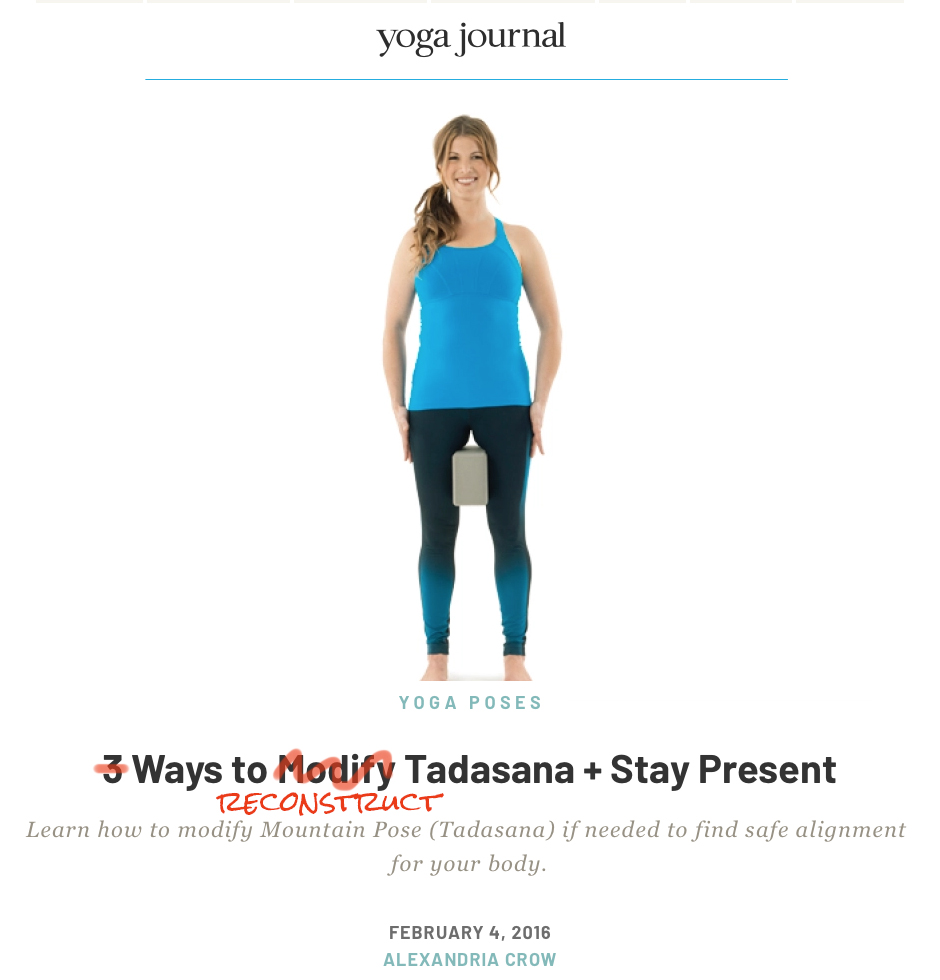
| Back in 2016, I was in the midst of my third and final round with back pain that my asana practice was contributing to. I had started to understand that sometimes adjustments to the poses were necessary–but I still believed that a focus on strengthening, on alignment, on a highly focused and intellectualized approach to putting this foot there, tightening that muscle, and on and on would fix the problem presented in my yoga practice. |
| During that time, I wrote a piece for Yoga Journal on modifying Tadasana to find “safe alignment,” based on the adjustments I’d needed to make—I could no longer do Tadasana the way it was traditionally configured without aggravating my S.I. joints. But even with that personal understanding and good intentions, I still overlooked some key factors. These days, I see myself as a guide helping to facilitate an experience in which students are involved of their own volition. My role is to give them things to pay attention to and to notice so that they can exercise their agency based on the present moment’s experiences. That’s one of the driving concepts behind my Deconstruct to Reconstruct courses. |
| But back when I wrote this piece, I was fully in the mode of “shape saving”–trying to make the shape possible and safe through small adjustments while largely retaining the way people were used to it looking. I swapped one binary set of instructions for another—like saying if feet together didn’t work, let’s try hip’s distance apart. I wasn’t yet aware that skeletal variations mean that every person’s approach may be different and that trying to fit the person into the pose would never make a pose truly accessible for them in their yoga practice. At this time, I was traveling frequently teaching workshops around the world, and I started instructing students to keep their feet hip’s distance apart in Tadasana. I assumed that teaching this modification would help everyone, as it in part had for me. But I found that there was always at least one person who concluded for themselves that having their feet together was the best approach for them. Then there was everything in between. Some people let their feet angle out a bit or landed in a little bit of an asymmetrical position. Based on the qualifications I was laying out–find a stable position where you feel like you wouldn’t wobble if you were jostled a little bit and where the position feels wise for you and your joints feel ok–people were making diverse choices. When they compared those choices to what they’d be told was the “right way to do Tadasana” they found that the version they’d self-composed felt so much better! I even found that, for myself, to stand in a way that feels like it has the stability of a mountain I have to have my feet hip distance apart and angled out a little, and some days my right foot kicks out a little more than my left. In this position folding forward feels so much better, and even things like Bridge Pose feel better too. I started to see the connection between this variability and the philosophies that I’d focused on from the start. I was taught that everything on the yoga mat should ask people to interact with the ideas presented in yoga philosophy in a direct way, asking them to identify theoretical concepts and the obstacles that are preventing them from actual yoga—afflictions, clinging, aversion. One of the central lessons of yoga is that everything changes constantly, and that’s ok. Problems arise when we become attached to a certain behavior or choice and end up caught in a cycle. Yoga asana is the same. In addition to the variations between people in terms of anatomy, the ways in which we interact with any given shape are constantly changing. From moment to moment and day to day, the way people come into a pose like Tadasana might be completely different, based on any number of factors. I had started to see this when I wrote that piece, but I didn’t go far enough. I didn’t mention that feet didn’t need to be straight ahead, and I still held onto the idea of specific alignments and muscles firing. I had yet to come to the place where I could let the choices my students made be up to them completely. I was always trying to add exertion and difficulty to things. If I let go of it all, wouldn’t the students just be standing there? But in truth, students bring that themselves. My role is instead to help them find their own way toward their own version of the poses by presenting options while preserving their agency. In many cases, yoga students need encouragement to do less rather than do more in their yoga practice. |





